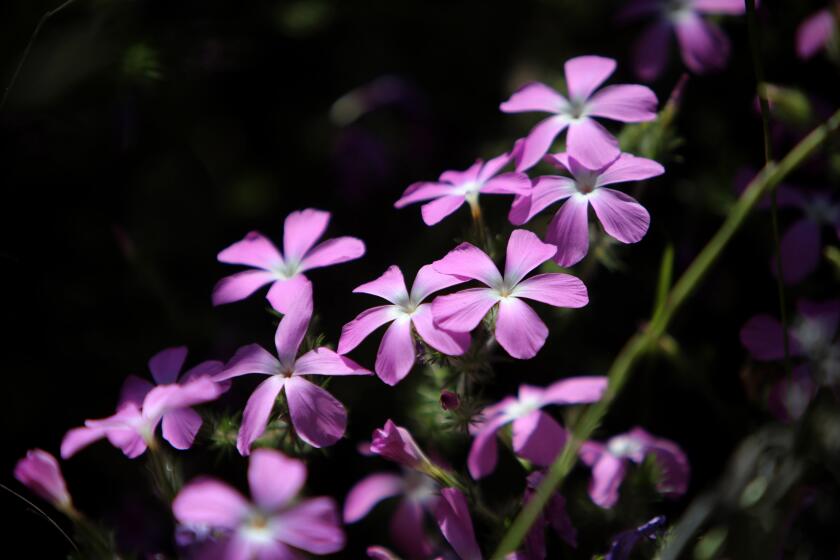An Ancient Garden of Wonders
Think Florence in the Renaissance and the images that come to mind--of Leonardo’s saints and Botticelli’s goddesses--are obvious inventions, too good to be true.
But artists of another sort, fabulously skillful ones, were also busy in the city. The earthbound masters in “The Flowering of Florence: Botanical Art for the Medici,” which went on view this week and remains till May 27 at the National Gallery of Art, did not paint nymphs and angels. They studied leaves and flowers. They portrayed fruit and veggies.
Jacopo Ligozzi (1547-1626), Giovanna Garzoni (1600-1670) and odd Bartolomeo Bimbi (1648-1729), whose cauliflowers frighten, deserve this recognition. They’re less famous than they should be. Their scrupulous attention, their click into sharp focus, and that ability to blend art, spirituality and science makes them wholly of their time, yet they’re also far ahead of it. Because the three of them together helped devise in Italy a variety of picture still very much in vogue; a strange sense of modernity rises from their art.
Their pictures for the Medici seldom summon up the cowled monks and intrigues, the poisonings and popes, of Renaissance romances. Instead they make you think of wildflower guides, and vase-of-flowers still-lifes from 17th century Amsterdam and 19th century Baltimore, and rural country fairs.
Suppose you grew a squash that weighed 160 pounds. You’d call the local paper to have that marvel photographed. When Cosimo III, the Medici grand duke, accomplished such a feat in 1711, he summoned Signor Bimbi to have his vegetable depicted.
Bimbi was a specialist in such kitchen-garden wonders--an 18-pound cauliflower, an 8-pound horseradish from hell. Among his most amazing oils is one that heaps before you 115 different varieties of pear.
The Medici loved gardens--flower gardens, herb gardens, bosky woods, parterres--and like breeders of top thoroughbreds, they had their favorites portrayed. Cosimo I (1519-1574), the first grand duke of Tuscany, had his private study in the Palazzo Vecchio filled with painted images of animals and plants. His descendant Giovan Carlo built himself a sitting room called “The Paradise of Flowers.” Such displays declared the grandeur of the Medici. So did their scented gardens, the rarities they grew there (irises from Persia, sunflowers from Peru), and the painted books they ordered to document their plants.
The paintings done on paper by Ligozzi were apparently produced for just such ducal volumes. They’re exceptionally precise and, although not idealized, exceptionally beautiful. His paintings have no background, their flowers float on whiteness, but they’re so tactile in their details they seem to jump into the room.
Ligozzi, in these pictures, developed a technique that combined the skills of a medieval miniaturist with those of an oil painter, although he was neither. He’d start by outlining his subject, in pencil. He’d then fill in the outline with a ground of flat white gouache. “To this prepared surface,” Lucia Tongiorgi Tomasi tells us in the catalog, “he added a succession of translucent layers of colors using an ever finer series of brushes. In this way he managed
One feels science in his pictures. There’s a cool scrutiny in the way the peering artist refuses to exclude the withering of a petal or the yellowing of a leaf.
The first flowers one encounters in the gallery’s exhibit, those from the 1400s, are not like this at all.
The disc-like roses, red and white, that one sees in the background of Domenico Veneziano’s “Madonna and Child,” circa 1445, aren’t specimens, they’re emblems. The Christian God who made the world filled it with his symbols. The red rose stands for martyrdom, the white rose for virginity. In Veneziano’s panel they grow from the same bush.
The flowers in the foreground of a later crucifixion by Pietro Perugino, circa 1483, though scrutinized more closely, remain as emblematic. The acacia by the cross represents Christ’s passion, the red poppy his blood, the bulrush our salvation. The lessons thus delivered aren’t botanical but biblical.
Even Leonardo, that fastidious observer, retains a background sense of all-pervading holiness in everything he draws. He cannot help but idealize. The curving lines that outline his pear blossoms and grasses in a 1483 drawing seem to yearn for circularity as if they were responding to the music of the spheres.
Giovanna Garzoni, who made paintings for the Medici from 1642 to 1651, cared less for metaphysics. Her arrangement on a single sheet of a lizard and a hyacinth, four cherries and an artichoke is less concerned with science, or echoes of the sacred, than it is with decoration.
The decorative impulse gradually becomes more and more important. One sees it in the Florentine pietre dure objects shown, those elegant mosaics of semiprecious stone. One feels it in the fabrics too. Those daffodils and roses in gold and silver thread are not there to teach botany or dogma, but just to please the eye.
Daffodils already are out here in Rock Creek Park. Spring is in the air. The show’s timing is just right.



